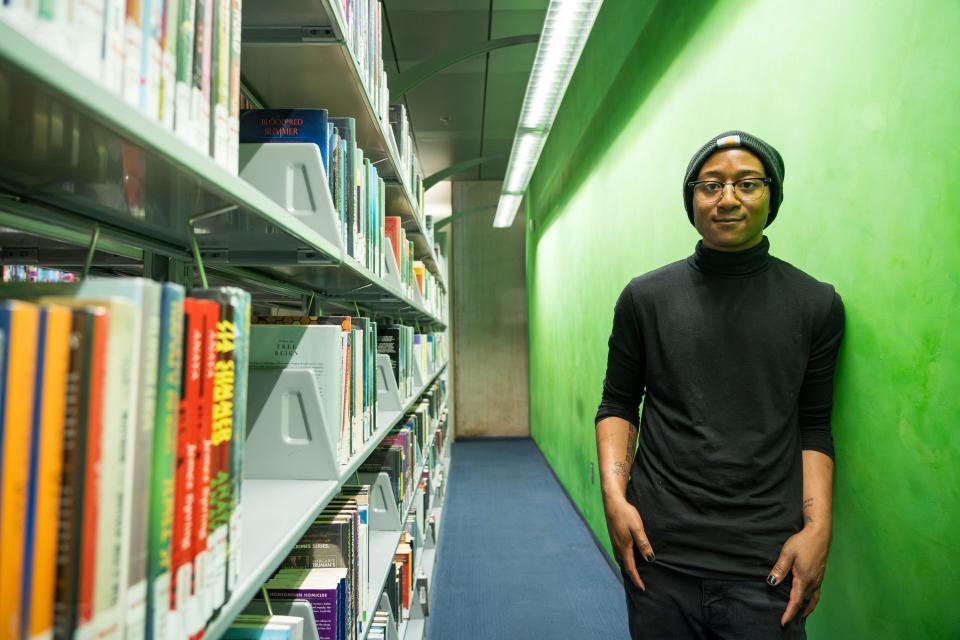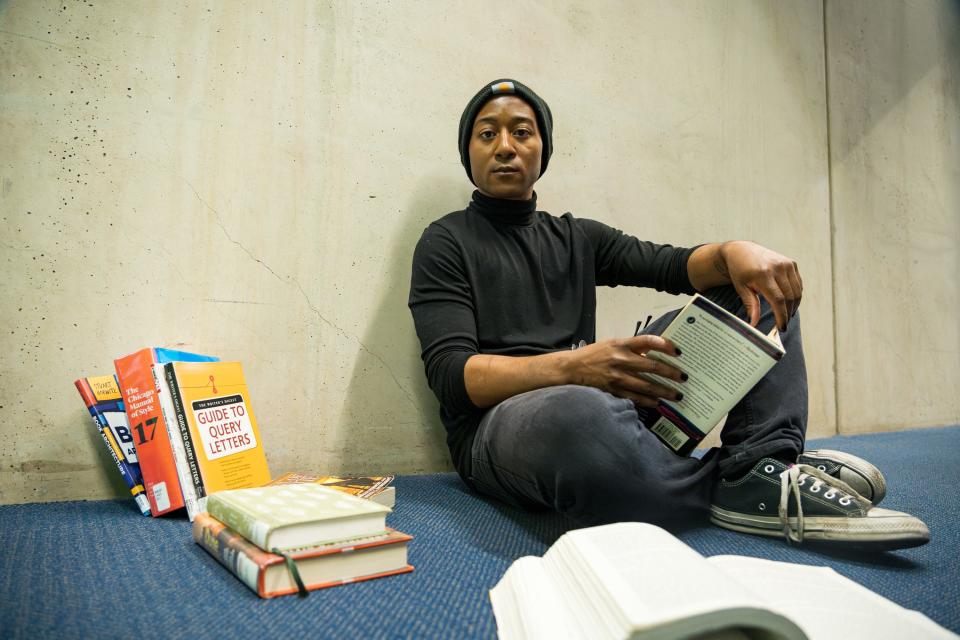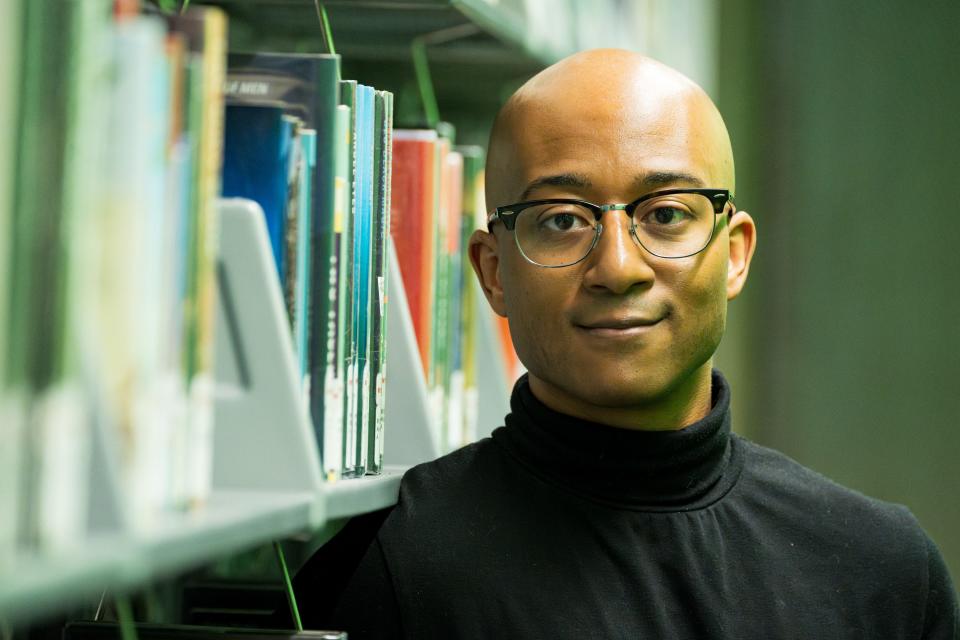'Seen and represented': Phoenix Author brings neurodivergent, LGBTQ characters to life
James Ramos can’t help but tell stories.
An Arizona-based young adult author, Ramos, who uses they/them pronouns, publishes stories for youth who feel out-of-place or underrepresented. They write for their dorky younger self, who ached to fit in, creating scenarios they never had the chance to experience in high school.
Ramos has three published works currently on the market: “That Girl, Darcy: A Pride and Prejudice Story” (2015), “The Wrong Kind of Weird” (2023), and “Daniel, Deconstructed” (2024), the latter two being their most recent releases. All three distinctly highlight Ramos’ journey with authorship and personal identity.
“The Wrong Kind of Weird” involves nerdy high school senior Cameron Carson as he navigates young love and mixed emotions when a summer fling with queen bee Karla Ortega drags him into senior year, along with Mackenzie Briggs, who is unapologetically herself. Carson is faced with a battle between his head and his heart — between fitting in and finding himself.
“Daniel, Deconstructed” follows Daniel Sanchez, a high schooler with autism, as he navigates matchmaking his soccer star best friend, Mona Sinclair, and nonbinary new student Gabe Mendes. During this endeavor, Sanchez navigates the complexities of high school romance while learning to cope with his autism.
Through these stories, Ramos tries to reach out to young adults who need a helping hand or a safe space.
Growing up a writer
Ramos grew up in Minnesota in a very conservative religious household, where the arts were seen as trivial and impractical. Since writing was not seen as a useful pastime, they learned to hone their craft in secret, starting their writing journey as early as 8 years old.
At one point, Ramos’s mom found all of their story-filled notebooks, “stacks” of them.
“She took them all out to the grill in our backyard and burned them, and I had to watch,” Ramos told The Arizona Republic. This pushed them to give up on storytelling for a short period. During that time, Ramos began to believe that their writing wasn’t worth the strife it brought into their life.
But eventually, the words came calling. “I realized I can’t stop telling stories, I’m just compelled to,” they said. “That’s when I kind of knew that this is something that is very important to me so I’m just going to pursue it.”
It took time, but eventually, Ramos was able to publish their first book in 2015.
Today, having made Arizona their current home, they spend their time at Valley bookstores, like Changing Hands in Tempe, find joy at different comic conventions cosplaying their favorite superhero, Spider-Man, and find purpose in speaking with teens and young adults about the meaning behind the beloved characters that make their novels come to life.
Inspiration and emulation
Ramos’ reading and writing journey started with the book their sister carried in her purse at all times, Jane Austen’s “Pride and Prejudice.”
“I fell in love with it,” Ramos said, referring to both Austen’s storytelling and character-building abilities.
“I try to capture some of that in my books,” they said of the 19th-century author’s wit. Like Austen, Ramos tries to have the characters make minute observations and judgments that can provide a new perspective to a situation that would have been mundane otherwise. Ramos places characters in familiar settings to readers but tries to give the situation a different spin, they said.

“With pretty much everything, I think, ‘What would Jane Austen do? How would she write these characters?’” Ramos said.
The complexity of Frank Herbert’s “Dune” series also appealed to them and has helped them to strengthen and take risks with their writing.
“I try to remind myself not to be afraid to have a bunch of characters because that just gives you more room to play and more to bounce off of.”
When writing characters, Ramos tries to keep their function in mind, considering what roles are being filled and how important they are to the overall narrative.
Ramos takes the intricacy and attention to detail that they came to love and appreciate in Austen and Herbert’s work and tries to apply it to their contemporary writing, offering them unique pathways to investigate identity in young adult literature.
For Ramos, creating these stories involves so much more than just writing, becoming enthralled in the characters' lives and journeys and finding it difficult to let go of them as projects come to an end.

Their first book, a “Pride and Prejudice” retelling titled “That Girl, Darcy,” had Ramos grieving characters once the book was published and the project complete. “When it was over, I got super depressed because it was like saying goodbye to people I had spent so much time with, so I was really sad for a couple of months,” they said.
But it became a learning experience.
As their career progressed and they began working with a team, the writing process was far more involved and required them to spend more time with the characters. As their work on “The Wrong Kind of Weird” was wrapping up, Ramos felt ready to move on and tackle “Daniel, Deconstructed."
Knowing what writing project comes next “makes it easier to break with the characters,” they said, describing the dynamic between writer and characters similar to a “friendship.”
'Being a teenager is a lot'
For Ramos, their writing reflects different eras of their life and their personal connection with identity.
“I think the themes are what have evolved with me,” Ramos said. “‘The Wrong Kind of Weird’ was about embracing who you are and owning your weirdness, and then ‘Daniel, Deconstructed’ is a similar theme, but it’s a little bit different because it’s about being autistic.”
The young adult author’s exploration of their own identity — being neurodivergent and non-binary — has allowed them to connect with younger audiences, they said, recalling a recent trip to Baltimore where they spoke with both high school and middle schoolers.
Ramos said they appreciated the bluntness of the young audiences, noting that after they told the seventh-grade crowd they were non-binary, the audience clapped.
“I’ve never been applauded for, like, coming out,” they said. “It gave me a lot of faith in the younger generations, they’re doing alright.”

As Ramos recalled their young adulthood, a singular motif became overwhelmingly clear: being a teenager is a lot. There is a seemingly endless parade of firsts and larger-than-life emotions, which is why they feel that youth representation in literature is crucial.
“Young readers are important, especially teens and middle-grade. I think it’s really important that they have literature where they feel seen and represented,” they said. “The books that I read when I was that age, they still stick with me now.”
Industry and community
It took Ramos ten years to find an agent as they launched their career in writing. Now, they work with an agent, a publisher and a team of editors.
The publishing company they work with, Inkyard Press, shares the same determination as Ramos: produce stories that are diverse and inclusive.
"For young adult readers, tales of identity can help to offer hope and understanding as they discover who they are, and by reading a diverse array of stories, they can begin to understand how they fit into the world," Inkyard publisher Loriana Sacilotto said.
“It’s been so gratifying to see the enthusiasm from booksellers, librarians, and readers for James’s novels as an important new inclusive voice in YA," Sacilotto said.
More prevalent than Ramos' team of editors, however, is their community.
“I think I owe a lot of my journey and what has happened to the people that I’ve met because they’ve allowed me to be myself,” they said.
Ramos said they have found understanding in people who are like them, who are “openly, unabashedly nerdy.” Their support system is primarily cosplayers and authors, they said.
Finding themselves has been a process. When they were younger, Ramos tried to be someone they were not. They suppressed the nerd in them to try to fit in and be well-liked.
As they continue to embark on their journey of authorship, Ramos has fully embraced their person — dorkiness and all.
Reach reporter Abigail Beck at abeck@gannett.com.
This article originally appeared on Arizona Republic: James Ramos grew up a nerdy teen. Now they write stories about them

